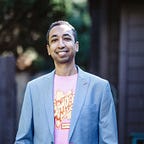A Fluid Identity
Every few years, I take a look at my personal portfolio site and revamp it a little. Usually with a new piece of work, or to take a look at my biography. And last thing I always do before closing the tab is to look at the bottom. It’s where I have the single word that is supposed to define who I am — Filmmaker.
When I was freelancing, the largest hurdle I faced was defining who I was in the entertainment industry. To be successful in this business, you need to have a specific role that you fit in. People need to understand who you are and what you do so that they’ll hire you. Even if you’re interests are varied, you need to be able to explain what value you bring that is hireable. Which creates a continual struggle to live up to the word you’ve defined as your career path. Which is ultimately is who you are.
We all live in this mindset of stasis in one form or another. We constantly define ourselves in simple terms that we think are set in stone. Even as our identities and lives are constantly shifting.
And yet we continually struggle against our own natural state of fluidity.
A False Premise
Before I left the United States my identity was simple:
Black kid with a White Father.
Anything to challenge the pride I felt in that statement was met with a fierce rebuke. Most of them with shouts, but sometimes with fists.
When my parents got divorced, I was angry with my father when he quickly got a new girlfriend. I felt he was disrespecting my Black mother. Just like so many had done in history. But when I moved away, my simple identity was immediately challenged in a way I hadn’t imagined.
I was 13 years old, and it was the first day of my new school in a new country. Every class was 45 minutes with a 15 minute break. During that break, a lot of the kids would either hang outside the classroom or wander the halls a bit.
I didn’t really know anyone and didn’t know how I was going to make friends with what I perceived as an obvious language barrier. So I stayed in the small classroom, alone. With about 5 minutes left on the break, a girl and her few friends approached me. To my surprise, she spoke perfect English. Her name was Lisa, her mother was from the Philippines and her father was Danish. She asked me where I was from as she had spent a fair amount of time living abroad and even had previously attended international schools.
I said I was from Chicago in the United States. She asked if my father was Danish and I said no — he was from Latvia. She asked about my mother and I said she was she was Black. The next question stopped me for a moment:
“So she’s African?”
I was confused.
I said Black — surely that was the universally known word for anyone with dark skin in America. What I didn’t realize was that my notion of identity didn’t apply in this new land.
Here, nation came first before ethnicity — which later introduced me to a new form of racism based upon nationality.
It took me a few more years to let go of the idea that I was Black first and American second. Even though everywhere I was introduced, the first descriptor was always that — American.
And so, for the first time, I began to finally see myself that way.
When I returned to the US for college, the topic of where I went to high school seem to come up frequently. Whenever I answered — Denmark — usually the assumption was that my dad was in the military. Or if one of my parents were Danish, or if I was.
Although neither my parents nor I are Danish by way of birth. I can’t say that there is not a part of me that isn’t Danish. I spent most of my teenage years there. I got used to certain traditions like singing to a tree, drinking warm red wine for Christmas, and learning to be in a state of hygge before it became an American hipster obsession. There are subtle parts of me that are probably, in truth, Danish. Even though I have no Danish ancestry.
There are parts of me that embody all the places I’ve lived and visited. No matter how long I’ve stayed. A piece of it became a part of me and I carry it always.
The same holds true for us all.
Embracing Out Nature
We get stuck trying to define our identity in singular terms. We try to find a single word that defines our nature — whether it be race, career, religion or anything else. The truth is all the places we have been, experiences we’ve had, and people we’ve gotten close to inform us of who we are. They are parts of us that can’t be segmented or separated. But rather embraced and added to the fabric of who we are.
This article and the Blended Future Project is the result of the embrace of that fluid identity. Once I began to eschew defining myself in simple terms but embraced all of them — life changed for the better. I saw the whole of what I could become and the relationships that I could build. It opened the possibilities of a brand new life that I wake up excited each day to be a part of.
Rather than a sentence, our identity is a story. One that is continually being written.
Even after we are no longer a part of it.
